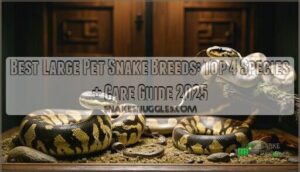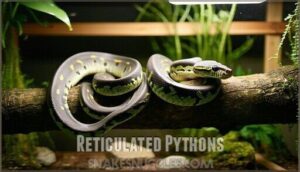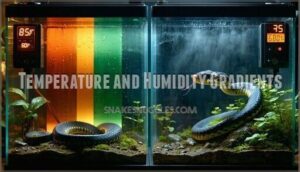This site is supported by our readers. We may earn a commission, at no cost to you, if you purchase through links.

You’ll master their health by maintaining proper thermal gradients, feeding frozen-thawed rats with tongs, and creating secure habitats that function like a bedroom, kitchen, and gym combined. Regular vet checkups catch respiratory infections early, while consistent gentle handling builds trust.
Monthly weight checks prevent obesity—the silent killer of captive snakes. Smart keepers know the real secrets lie in understanding each species’ unique quirks.
Table Of Contents
- Key Takeaways
- Best Large Pet Snake Breeds
- Choosing The Right Large Snake
- Setting Up a Healthy Snake Habitat
- Feeding and Nutrition for Large Snakes
- Maintaining Health and Welfare
- Frequently Asked Questions (FAQs)
- What is the best big snake to have as a pet?
- How do you keep snakes healthy?
- What is the best pet snake that doesn’t bite?
- What snakes can be handled the most?
- How much does it cost to own a large snake?
- Can large snakes recognize their owners?
- Are large snakes dangerous to other pets?
- Whats the best way to transport a large snake?
- How much do large pet snakes cost annually?
- What permits are required for owning large snakes?
- Conclusion
Key Takeaways
- Choose the right species for your experience level – Ball pythons work best for beginners with their docile nature, while reticulated pythons need expert-level skills and can reach 30+ feet.
- Create proper habitat zones with secure enclosures – You’ll need fortress-level security, thermal gradients (85-92°F warm, 75-80°F cool), and 60-80% humidity with multiple hiding spots.
- Feed frozen-thawed prey safely and prevent obesity – Use feeding tongs, match prey size to your snake’s thickest body section, and weigh monthly since overfeeding kills more captive snakes than underfeeding.
- Handle gently and watch for health warning signs – Start with short, consistent sessions to build trust, and get immediate vet care for respiratory distress, abnormal shedding, or lethargy.
Best Large Pet Snake Breeds
When you’re ready to step up from smaller species, these four large snake breeds offer the perfect balance of manageable care and impressive size.
Each species brings unique traits, from the docile ball python‘s calm nature to the striking patterns of carpet pythons, making them excellent choices for experienced keepers.
Boa Constrictors
Boa Constrictors rule the Large Species category among Pet Snakes. These gentle giants need spacious Boa Habitat with proper heating zones. Their calm Snake Behavior makes Constrictor Care manageable for committed owners. Monthly Boa Feeding keeps them healthy.
- Require 8x4x4 feet minimum enclosure space
- Need 88-92°F basking spot with cool side at 78-80°F
- Feed appropriately-sized frozen/thawed prey monthly
- Live 20-30 years with proper Snake Care
- Grow 6-10 feet, making them impressive Reptile Pets
Ball Pythons
Ball pythons, also called Royal Pythons, rule the Pet Snakes world with their gentle nature and stunning Ball Python Morphs. These Python Habitat masters show docile Snake Behavior, making Snake Care simple for beginners.
Their calm temperament and manageable size create perfect conditions for learning proper Feeding Techniques. Unlike aggressive Snake Breeds, ball pythons rarely bite, earning their reputation as ideal starter serpents.
Carpet Pythons
Carpet pythons bring striking beauty and manageable temperament to snake owners seeking larger pet snakes. These Australian natives showcase stunning carpet python morphs and adapt well to captivity with proper python habitat setup.
- Size: 6-9 feet average, perfect for experienced snake owners
- Temperament: Semi-arboreal with calm snake behavior when handled regularly
- Care: Moderate pet snake care requirements with specific feeding techniques
- Varieties: Multiple morphs available through selective breeding methods
Reticulated Pythons
The reticulated python reigns as the world’s longest snake breed, reaching 30+ feet. These giants demand sophisticated Pet Snake Care skills and massive habitat design considerations.
Their feeding strategies require adult prey items, while their unpredictable snake behavior makes them unsuitable for beginners. Expert-level snake breeds like reticulated pythons need specialized knowledge.
Choosing The Right Large Snake
You’ll want to match your snake choice to your experience level, living space, and commitment to long-term care. Some species like reticulated pythons can reach 20+ feet and live 30 years, while ball pythons stay more manageable at 4-6 feet with equally impressive lifespans.
Size and Growth Expectations
Understanding each Pet Snake Species’ growth patterns helps you plan for years ahead. You’ll need different setups as your snake matures, from juvenile enclosures to adult-sized habitats.
- Ball Python growth reaches 40-45 inches by maturity, with females larger than males
- Growth Rates peak in first 3 years, then slow dramatically after sexual maturity
- Weight Expectations vary by species – Royal Pythons stay manageable while others exceed 60 pounds
Snake Length predictions aren’t exact since genetics play the biggest role. Feeding Schedules affect growth speed, but power-feeding risks health problems. Watch for Maturity Signs like reduced growth rates around ages 3-4. Corn Snake varieties stay smaller than most Snake Breeds discussed here. Proper snake care involves understanding reptile care guidelines to guarantee the health and well-being of your pet.
Temperament and Handling Needs
Beyond size considerations, you’ll need to evaluate snake behavior and handling requirements. Ball Python species usually display calm temperaments, making them ideal for regular interaction.
Successful handling techniques involve confident, slow movements to support stress reduction. Docility factors vary by species – some naturally resist handling while others thrive on socialization methods.
Pet snakes respond differently to human contact, so research specific snake breeds before committing to ownership.
Experience Level Required
Your snake handling techniques matter more than you think. **Beginner snake owners shouldn’t jump into expert-level pet snakes without proper preparation.
**
Ball pythons offer the perfect starting point, while reticulated pythons demand years of experience. **Care requirements vary dramatically between snake breeds for beginners versus skilled species.
**
Start simple, build confidence, then tackle bigger challenges when you’ve mastered the basics.
Setting Up a Healthy Snake Habitat
You’ll create the foundation for your snake’s long-term health by getting the habitat right from day one. Think of it like setting up a studio apartment that’s got to work as bedroom, kitchen, and gym all rolled into one—your snake needs specific zones for heating, hiding, and humidity to thrive.
Your snake’s enclosure must function as bedroom, kitchen, and gym combined—with proper heating, hiding, and humidity zones for long-term health
Enclosure Size and Security
Your snake’s home needs fortress-level security to keep your scaly escape artist safely contained. Choose reptile enclosures with durable enclosure materials like PVC or glass that won’t crack under pressure.
Secure lids with strong locking mechanisms prevent your pet from becoming an unexpected house guest elsewhere. Proper ventilation systems maintain airflow without compromising escape prevention, keeping your snake species comfortable and contained.
Temperature and Humidity Gradients
Your large pet snake needs thermal gradients and humidity control to stay healthy. Heat sources should create climate zones with warm areas at 85-92°F and cool spots at 75-80°F. Snake enclosures require proper ventilation systems to manage humidity between 60-80% for most snake species.
Digital thermometers placed in both zones help you monitor your reptile terrarium accurately. Reptile enclosures benefit from strategic water bowl placement and occasional misting to maintain proper gradients throughout the habitat.
Maintaining ideal temperatures is vital, and understanding UVB lighting needs can help create a healthier environment.
Substrate, Hides, and Enrichment
Your snake’s foundation matters more than you’d think. The right substrate options create a clean, comfortable base for your reptile terrarium. Paper towels work great for beginners, while cypress mulch retains humidity naturally.
Strategic hide placement gives your pet snakes security:
- Warm side hide – Position near heating element for digestion
- Cool side hide – Place on opposite end for temperature regulation
- Humid hide – Add damp moss for proper shedding cycles
- Elevated perches – Include sturdy branches for climbing snake species
Environmental decor shouldn’t just look good—it should work. Fake plants provide visual barriers, while water bowls double as humidity boosters. Smart enrichment activities keep large snakes mentally stimulated. Remember, snake enclosures mirror nature best when they offer choices. Your snake hiding behavior tells you if you’ve nailed the setup.
Feeding and Nutrition for Large Snakes
You’ll need to master feeding schedules and prey sizes to keep your large snake healthy and thriving.
Getting nutrition right prevents costly health problems like obesity, malnutrition, and digestive issues that can plague even experienced snake owners.
Safe Feeding Practices
Proper feeding transforms your snake from stressed to thriving. Frozen rats thawed completely work best for pet snakes, eliminating injury risk from live prey. Follow prey size guidelines: feed items matching your snake’s thickest body section. Snake nutrition depends on consistent schedules and appropriate food variety.
Always use feeding tongs to prevent accidental bites during meal time. Monitor feeding frequency based on age and species. Watch for digestion issues like regurgitation, which signals temperature or stress problems.
Diet by Species
Each species demands specialized feeding strategies to thrive in captivity. Your snake’s dietary needs vary dramatically based on size, age, and natural prey selection patterns.
- Boa Constrictors: Feed appropriately sized frozen rodents every 1-2 weeks for adults, weekly for juveniles
- Ball Pythons: Offer mice or rats matching body width every 1-2 weeks; pre-killed reduces injury risk
- Carpet Pythons: Provide varied diet of rodents, chicks, quail every 7-10 days for ideal snake nutrition
- Reticulated Pythons: Progress from mice to rabbits as they grow; feed every 1-2 weeks for proper pet care
Preventing Obesity and Malnutrition
Balancing your snake’s nutrition is key to preventing serious health problems down the road. Regularly monitor their body condition by checking for visible fat pads or rib definition. Adult large snakes should eat every 3-6 weeks, while juveniles need weekly feedings.
| Obesity Prevention | Malnutrition Risks |
|---|---|
| Monitor body condition monthly | Underfeeding stunts growth |
| Follow species-specific feeding schedules | Poor nutrient balance causes deficiencies |
| Avoid overfeeding sedentary snakes | Inadequate prey size limits nutrition |
| Maintain proper temperatures for digestion | Irregular feeding creates stress |
| Provide appropriate prey sizes only | Wrong diet types lack essential nutrients |
Healthy feeding involves matching prey size to your snake’s thickest body part and sticking to consistent schedules. This approach ensures ideal reptile ownership success.
Maintaining Health and Welfare
You’ll keep your large snake healthy by watching for early warning signs and creating proper handling routines.
Regular vet checkups, clean environments, and gentle socialization prevent most health problems before they become serious issues.
Common Health Issues and Prevention
Preventing health problems beats treating them later. Respiratory infections from poor humidity and temperature control cause wheezing and mouth bubbles in pet snakes. Watch for shedding problems, which signal environmental issues.
Regular parasite prevention through quarantine and vet checks stops worms and mites before they spread.
Obesity risks increase with overfeeding—weigh your snake monthly.
Quality veterinary care catches problems early, especially in snake breeding programs where diseases spread quickly between reptiles.
Handling and Socialization Tips
Start handling sessions slowly to build trust with your snake. Gentle handling creates social bonding and reduces stress over time. Support your snake’s body fully during interactions – never grab just the head or tail.
Regular, short sessions work better than long ones for docility training. California King Snakes and Corn Snakes respond well to consistent routines.
Watch for defensive postures and give your pet snakes space when needed.
Signs of Illness and When to See a Vet
Watch for these red flags in your pet snake: lethargy and anorexia signal serious illness . **Abnormal shedding, especially retained spectacles, needs attention.
Respiratory distress like open-mouth breathing or wheezing requires immediate vet care.
**
Scale abnormalities, weight loss, or neurological signs warrant professional evaluation.
Regular parasite detection through fecal exams keeps snake species healthy.
Frequently Asked Questions (FAQs)
What is the best big snake to have as a pet?
Ball pythons make excellent large pet snakes. They’re docile, easy to handle, and don’t require complex care. You’ll love their calm temperament and manageable feeding schedule.
How do you keep snakes healthy?
Like tending a garden that thrives with attention, you’ll keep snakes healthy through proper temperature gradients, regular feeding schedules, clean water, secure enclosures, and annual vet checkups.
What is the best pet snake that doesn’t bite?
Ball pythons are your best bet for a bite-free experience. They’re naturally docile and rarely show aggression. Their calm temperament makes them perfect for nervous first-time owners seeking gentle companionship.
What snakes can be handled the most?
Some docile companions tolerate frequent interaction better than others. Ball pythons, corn snakes, and kingsnakes handle regular sessions well when you’re gentle and consistent with your approach.
How much does it cost to own a large snake?
You’ll pay $50-$100 monthly for food, substrate, and electricity. Initial setup costs $160-$500 for terrarium, heating, and accessories. Vet visits run around $100 each when needed.
Can large snakes recognize their owners?
Your large snake doesn’t truly recognize you, but they’ll learn your scent and routine. They associate you with food and handling. Think familiarity, not friendship—you’re a warm tree.
Are large snakes dangerous to other pets?
Think of your home as a peaceful kingdom where different species must coexist. You’ll need careful supervision when large snakes interact with other pets.
Most incidents happen when prey-sized animals trigger hunting instincts, so separate housing protects everyone involved.
Whats the best way to transport a large snake?
Use a secure, ventilated snake bag or plastic container with air holes. Support the snake’s body weight completely. Keep temperatures stable and transport time minimal.
How much do large pet snakes cost annually?
Annual costs for your large snake usually run $200-400, covering food, heating, substrate, and vet checks. Boas and pythons eat $3-10 rodents monthly, plus electricity bills.
What permits are required for owning large snakes?
Like traversing a legal minefield, you’ll need permits in many states for large snakes. Check your state’s wildlife department first—requirements vary wildly from banned ownership to detailed licensing.
Conclusion
Successfully keeping the best large pet snake breeds and how to keep them healthy requires dedication, preparation, and ongoing commitment. You’ve learned about proper enclosures, temperature gradients, and feeding protocols.
You’ve discovered species-specific needs for ball pythons, boas, carpet pythons, and reticulated pythons. Monthly weight checks prevent obesity, while regular vet visits catch problems early.
Your snake’s health depends on consistent care, proper handling, and understanding their unique behaviors. With patience and knowledge, you’ll enjoy years of rewarding companionship with your scaled friend.
- https://www.reptilecentre.com/blogs/reptile-blog/7-awesome-pet-snakes
- https://www.reddit.com/r/snakes/comments/zrxb5x/wanting_to_get_a_larger_snake_what_would_you/
- https://community.morphmarket.com/t/large-beginner-snakes/17853
- https://reptizoo.store/blogs/reptizoo-reptiles-blogs/how-to-choose-a-snake-enclosure
- https://a-z-animals.com/blog/ball-python-feeding-chart/
















